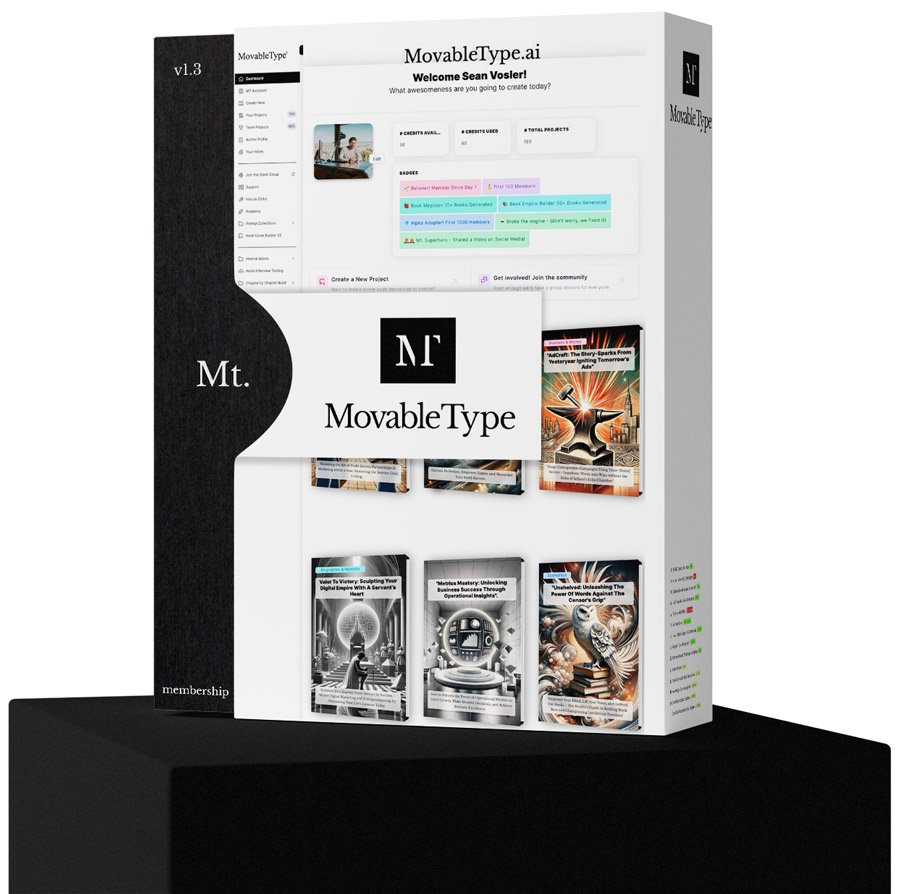- By: Sean Vosler
How to Develop Your Unique Voice, Attract Customers, and Dominate the Market.
Your Book's Introduction - "The Preface"
Congratulations! Your book aced the “judge a book by its cover” test. But the journey doesn’t stop there – next up is the intro or “Preface.” At this phase, MovableType carefully engineers the preface to serve as an engaging “sales letter” designed to hook your readers, keep them engaged, and start the bond that will be nurtured between you and the reader moving forward.
Most writers are tempted to only talk about themselves in the introduction, but this is the opportune time to help your reader understand why THEY will benefit from reading your book.

Paige Turner
Your Project Guide
Preface
"The riskiest thing we can do is just maintain the status quo." – Bob Iger
In the vibrant dance of the marketplace, where every hustling entrepreneur competes for the limelight, a unique voice is not just an asset; it's paramount to survival. Mastering the Entrepreneurial Message is a melodic composition of insights, strategies, and real-world wisdom, distilling the essence of marketing alchemy passed down from the maestro of market domination himself, Alex Hormozi. This book unfurls like a map, guiding aspiring entrepreneurs through the realms of message crafting, audience captivation, and market conquest.
Imagine, if you will, an orchestra without a conductor, a ship devoid of a compass; that is the predicament many young entrepreneurs face within the thunderous cacophony of global commerce. I recall the trials of countless keen minds I've met, brimming with fire and innovation, yet murmuring in anonymity, sidelined in a world eager to silhouettes, not whispers. It was the echoes of their potential, unamplified, that stroked the keys to my resolve, manifesting these pages you now hold—a torch to light the path of the unheard.
This narrative sprouted not just from the fertile soil of experience but from the ceaseless curiosity to dissect successes, to understand what turns the gears of giants. It is etched with tales of phoenixes rising from the ashes of obscurity, their wings painted with the bold hues of authenticity and audacity. From Hormozi's vault of victory, I drew the essence, woven seamlessly into pragmatic approaches, ensuring that sagacity may flourish where once was doubt.
With a grateful heart, I acknowledge the mentors, peers, and mavericks who shared their triumphs and tribulations, painting the canvas of this manuscript. A special nod to the unwavering raft of family and friends, whose encouragement constituted the bedrock of this undertaking.
Dear reader, your investment in these pages dishes out more than knowledge; it serves as the quintessence of empowerment. This dialogue seeks the company of young visionaries driven to rise above the din, to those parched for a drop of mentorship in an often desolate desert of guidance. You, thirsty architects of change, are poised to thread the needle, imbuing your tapestry with the vibrance it truly deserves.
In the ebb and flow of literary encounters, words soaked in humility often whisper the loudest counsel. So, let us walk together through this bountiful orchard of opportunity, with senses piqued, as we hand-pick ingredients ripe for your entrepreneurial feast. With open palms and eager hearts, I invite you to delve beyond the veil of the known, to uncover the treasure trove that awaits within these pages.
Together, we will carve a path to chiaroscuro, where the brilliance of your message eclipses the shadows of the commonplace. Thank you for choosing this journey of enlightenment. Let us embark on this expedition, not as mere spectators but as intrepid conquerors of the entrepreneurial domain.
Your First Chapter
The first chapter is like the front porch of a book. It invites your readers in, gives them a glimpse of what’s inside, and warmingly invites them to step through the door. MovableType crafts the first chapter to directly address the central issue or problem the book revolves around. This approach ensures that the initial chapter delivers a clear and compelling solution, setting the tone for the book’s overarching theme.

Paige Turner
Your Project Guide
Chapter 1: Building Relationships and Emotional Connections
The afternoon sun filtered through a hazy horizon, casting a diaphanous glow on the cobblestone streets of a small European town. In the corner of the market square, a man named Julian absently adjusted the lapels of his linen jacket as he watched a tapestry of people unfold before him. Shop owners, travelers, and townsfolk mingled and bartered, each interaction woven with an undercurrent of need and desire, observable only to those who knew to look.
Julian, a merchant by trade and a philosopher at heart, pondered the invisible threads that tied these people together. His own shop, nestled between a florist and a bakery, was an alchemist's cabinet of curiosities, offering objects from distant lands and stories waiting to be heard. Yet, it was not the lure of the exotic that called his customers back, but the sense of belonging and understanding he fostered with every conversation, every shared secret, and every smile that spoke of empathy and connection.
Inside the shop, each object held not just a price, but a narrative. Julian believed that the value of his wares rested not in their rarity but in the emotional resonance they carried. A brass compass was not a mere tool for navigation but a companion for the lonely voyager. A hand-painted vase, a receptacle for cherished memories. And so the world within his walls became a refuge for souls seeking solace in the stories that mirrored their own.
The day ebbed, and the warmth of the fading light invited quietude. Julian stood at the threshold of his establishment, the aroma of baking bread and fresh florals in symphony with the leather and polished wood scent of his shop. His gaze fell upon a young couple, pondering over a delicate locket. Their eyes met, and in that brief exchange, a dialogue beyond words unfolded. Here was the moment Julian thrived upon—the art of seeing, truly seeing, what lay behind their gazes. What dreams did they share, what fears did they harbor, and how could this small token become a vault for their future aspirations?
As the sky turned a deeper shade of cerulean, Julian contemplated the essence of his true vocation. It was not the selling of trinkets nor the acquisition of wealth, but the weaving of humanity's collective narrative through the exchange of goods, spoken words, and silent understandings. He realized that his gift was not in the trade but in the silent language of empathy.
Could it be that the true currency of our lives is not the coin that clinks on counters but the intangible wealth of knowing and being known?
Unlock the Heart of Your Market
Imagine entering a crowded marketplace, each stall bursting with color, each vendor vying for attention. Now picture yourself weaving through, searching not just for a product, but for a connection, a story that resonates—you're looking for an experience that lingers. That's precisely what your customers are seeking from you. The essence of your entrepreneurial journey isn't just about the exchange of goods or services, it's about fostering relationships and connections that transcend the transactional nature of business.
Delving into this chapter is akin to taking the first step in capturing the soul of your clientele. We explore how to court your audience, not with fleeting pitches, but with enduring bonds wrought from deep understanding and genuine emotion. Building relationships with your target audience harnesses a power far greater than any slick advertising campaign can hope to achieve. It’s like planting a seed that could grow into a mighty oak in the hearts of those you serve.
The art of creating emotional connections with customers is like penning a love letter to your market; it requires vulnerability and sincerity. Customers do not just buy products; they buy better versions of themselves. By learning techniques that evoke emotion, we can craft marketing messages that transform casual observers into ardent admirers.
But how can we know the whims of an audience's heart? Identifying the needs and desires of your target audience is akin to reading a well-loved diary – it requires attention to detail, empathy, and a touch of foresight. This chapter will guide you through the labyrinth of human desires, showing you how to align your offerings with the aspirations and pains of your audience.
The Compass of Connection: A Descriptive Framework
To navigate the bustling bazaars of business, one must possess a compass—a Descriptive Framework that pinpoints where to cast your entrepreneurial message in the ocean of customer consciousness. Let's christen this compass "The MAESTRO Framework," where each letter stands for a critical aspect of your messaging strategy.
Target Audience: Listen to the stories whispered in every corner of the market. Your customers have tales to tell—of needs unmet and wishes unfulfilled. By understanding these narratives we carve out our niche, for within those stories lies the blueprint for connection.
Value Proposition: It's the melody that allures, the harmony that holds. Your value proposition is the siren song of your brand, distinguishing you from the indistinct hum of the marketplace. It's your promise, your battle cry, and your lullaby—all in one.
Brand Identity: Every brand has a tenor, a timbre that resonates with a specific crowd. Defining your brand identity is like composing a symphony—each note must contribute to a singular, unmistakable tone, setting the stage for an unforgettable presence.
Messaging Strategy: Craft your narrative with the care of an artisan. Whether through impassioned tales or tranquil testimony, your messaging strategy conveys the ethos of your brand with consistency and clarity. Like the intricate steps of a dance, it communicates purpose and passion in every gesture.
Channels and Platforms: The mediums through which we broadcast our stories are as varied as the tales themselves. We must choose our platforms as a maestro chooses their instrument—each selected for its ability to convey the depth and texture of our message to a captivated audience.
Message Delivery: Consider the presentation of your symphony. The crescendo of an emotion-laden story might be best delivered in the intimate setting of an email, while the vibrant chorus of a product launch finds its stage on the vast amphitheaters of social media.
The Interplay of Harmony and Rhythm
The MAESTRO Framework not just outlines individual components, but underscores the symphony that arises from their interplay. The rhythms of our strategies, the harmonies between our channels, and the resonance of our brand identities—these create a marketing orchestration that no single instrument could achieve alone.
Our framework dances across time and conditions, its tempo shifting with market currents, yet grounded by the unwavering beat of core principles. It respects the dynamic balance of elements—the feedback loops of customer engagement and the stability of a coherent brand narrative.
In the Orchestra Pit of the Marketplace
In practice, this framework acts as your conductor's baton, ensuring that every department, campaign, and decision harmonizes with the entrepreneurial opus you are composing. It molds your capabilities, so you're no longer just a vendor in the market, but a maestro of messaging, orchestrating an experience that captivates and endures.
As we place the MAESTRO Framework center stage, we also draw the curtains to reveal the expansive landscape of this book. In upcoming chapters, we delve into the finesse of marketing on a shoestring, the fluidity of adapting to market rhythms, and the fusion of data and narrative into a compelling story.
This overture has teased the themes you'll encounter—a prelude to the symphony of entrepreneurial messaging. In the chapters to come, we uncover the elaborate dance of understanding your audience, crafting your voice, and leveraging technology, all leading towards a standing ovation in the grand theater of business.
Bear with me, as we step into the role of both student and maestro—learners in the craft of connection and leaders in the art of messaging. Together, we shall rouse the hearts and minds of your audience, composing a narrative of success that echoes long after the final applause.
Unveiling the Core of Effective Marketing
When we peel back the layers of entrepreneurial success, at the core lies the ability to communicate a message that resonates. It's the fundamental notion that marketing isn't about bombarding your audience with sales pitches, but rather, about nurturing a connection that feels as natural as a friendship. Like a tree that requires the right soil and climate to thrive, a business needs to understand the environment in which its customers grow and flourish.
Imagine you're at a bustling marketplace. Amongst the shouts and vibrant colors, your task isn't merely to yell the loudest, but to tell a story that turns heads. When someone stops to listen, that's the magic of effective marketing. You're not selling a product; you're sharing a solution to a need they whisper only to themselves. This isn't a matter of guesswork; it's an intentional and well-researched strategy to grasp the subtle nuances of your target audience's desires and pain points.
Let's say you're a gardener. You wouldn't plant without understanding the particulars of each seed, just as in marketing, you wouldn't offer a solution without comprehending the unique challenges your customers face. What this teaches us is that marketing success is contingent upon a deep understanding of the people you're trying to reach.
Each fact and figure about your consumer is a thread in the tapestry of relationship-building. However, weaving these threads requires more than a robotic calculation of interests and behaviors. It begs for a tender touch, one that crafts narratives and ignites emotions, because people are far more intricate than simple data points can convey.
To encapsulate, marketing is not about the hard sell, but about cultivating authentic relationships and touching hearts, which, in the end, fosters loyal customers.
The Melody of Your Brand
Discovering Your Unique Voice
Marketing is akin to composing a song: both require a clear voice and the right pitch to strike a chord with an audience. But before you can compose this masterpiece, you need to know who's listening.
Step One: Identify Your Target Audience
Invest time in research. Understand who the listeners of your melody are, their tastes, and the music that moves them. Their age, location, interests, and struggles are the notes you'll use to compose your score. This understanding can take days or even weeks, but it's the crucial first step toward creating a symphony.
Step Two: Define Your Brand Personality
Next, define the genre of your music. Is your brand bold, echoing the confidence of rock, or is it soothing like a soft classical piece? Your brand's personality should harmonize with your audience's rhythm. Developing your unique selling proposition is identifying your melody that will echo in their memory. This could be a week's work but is the bedrock of your brand identity.
Step Three: Craft Your Brand Message
Your mission and vision are your symphony's theme. It's that recurring tune that needs to be memorable yet simple, a phrase that can be hummed with ease. An elevator pitch should be as clear and succinct as a catchy chorus, something that can be communicated in the span of an elevator's journey between floors.
Step Four: Develop Your Brand Story
Identify pivotal moments in your brand's history just as you would chart the rise and fall in a musical composition. Narrate these moments to fashion a story that resonates with your listeners - this could unfold over months of careful plotting and rewriting.
Step Five: Refine and Test Your Message
Not all songs are hits on the first try. Use feedback to fine-tune your verses. Testing your message with different groups could take several rounds but knowing which version sings to your audience is indispensable.
Step Six: Embody Your Brand Message
Consistency across all channels ensures your song isn't distorted. Everyone on your team should know the lyrics by heart. Monitoring customer feedback and adjusting the tune accordingly is an ongoing process in perpetuating the harmony of your brand.
With a memorable name like “The Melody of Your Brand,” this process becomes an anthem for your marketing strategy. It's setting the stage for you to conduct a masterpiece. And at the end of it all, you'll know success by the encore your customers demand.
Could it be that discovering your brand's unique voice is the ultimate crescendo in your entrepreneurial symphony?
The Heart of Your Business Lies in Its Narrative
To truly understand the power of storytelling in business, consider the parallels with our own lives. Our narratives, composed of individual experiences, sculpt who we are. Similarly, a business's story is not just an account of its inception and growth—it's a living, breathing entity that connects with customers on an emotional level.
Step One: Identify Your Target Audience
This is like knowing whom you're narrating your life story to; is it a friend, a confidante, someone who shares similar dreams? This clarity isn't achieved overnight and may require weeks of consideration. It forms the basis of how you'll weave your narrative.
Step Two: Define Your Brand Personality
Here, you're giving your brand a voice. Will it be firm and authoritative, or friendly and approachable? This essence of your brand aligns with your audience much like matching your storytelling style to your listener's preferences, ensuring your chapters are received with keen interest.
Step Three: Craft Your Brand Message
Precision and passion are necessary as you develop your brand’s value proposition. Like the theme of a gripping novel, your message should captivate the audience and leave them wanting more.
Step Four: Develop Your Brand Story
Look into your brand's history, the struggles and triumphs, and share this narrative. Your brand story should unfold smoothly, keeping the audience engaged through various platforms, just as a tale might be told differently across a campfire, a book, or a movie.
Step Five: Refine and Test Your Message
Not unlike drafting a novel, seek reviews and critique. Use this feedback to revise your story, ensuring it resonates and remains relevant just as literary classics stand the test of time.
Step Six: Embody Your Brand Message
Each team member should live and breathe the brand's story, becoming a protagonist in this shared narrative. Frequent assessments will make sure the storyline remains true and that customer reactions are woven into the next chapter.
As we articulate stories that mingle our brand's experience with that of our customers, we foster a distinct narrative that is both personal and universally appealing. Engaging, adaptable, and timeless, the message is delivered not as a monologue but as part of a rich dialogue that values interaction and feedback.
By marrying the art of storytelling with the science of marketing, we intertwine learning objectives into a cohesive message; an entrepreneur's tale that compels, connects, and converts.
So, what have we learned in this chapter?
We started off by debunking the myth that marketing is solely about promoting products or services. Yes, that's a part of it, but it's not the whole picture. Effective marketing and business messaging are much more than just advertisements and sales pitches.
We've explored the idea that marketing is about building relationships and creating emotional connections with our target audience. And let me tell you, my friend, when you can build those connections and foster those relationships, magic happens. Your customers become loyal, they become advocates for your brand, and they keep coming back for more.
But how do we do that? Well, we've also discussed the importance of understanding the needs and desires of our target audience. When we truly understand our customers, when we get to the heart of what they want and need, we can tailor our messaging and offerings to better meet those expectations.
Think about it like this: if you were trying to sell a fancy sports car, would you focus on talking about the horsepower, engine specs, or even the price? Maybe, but what if you knew that your target audience was more interested in the feeling of freedom and exhilaration that comes from driving a fast car? Now you're speaking their language. You're creating an emotional connection.
So, what's the big idea here? It's simple: effective marketing and business messaging involve building relationships, creating emotional connections, and understanding the needs and desires of our target audience. By doing these things, we can attract customers, create loyalty, and ultimately dominate the market.
Now, my friend, I know what you're thinking. You're probably wondering how you can apply all of this to your own business. And that's a great question. Lucky for you, we have an entire book full of insights, strategies, and techniques that will help you develop your unique voice, attract customers, and unleash your business potential.
In the next chapter, we'll dive deeper into the first step of this process: developing your unique voice. We'll explore how to identify your core values, define your brand personality, and communicate your message in a way that resonates with your target audience. Trust me, my friend, this is where the magic really starts to happen.
So, buckle up and get ready for an incredible journey. This book has the power to transform your business and take it to new heights. Are you ready to unleash your entrepreneurial potential? I thought so. Let's get started!


